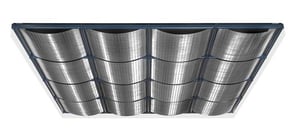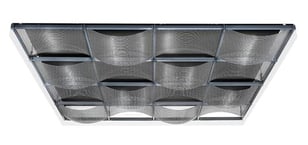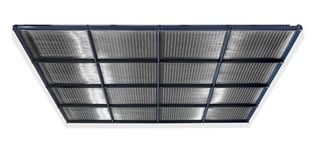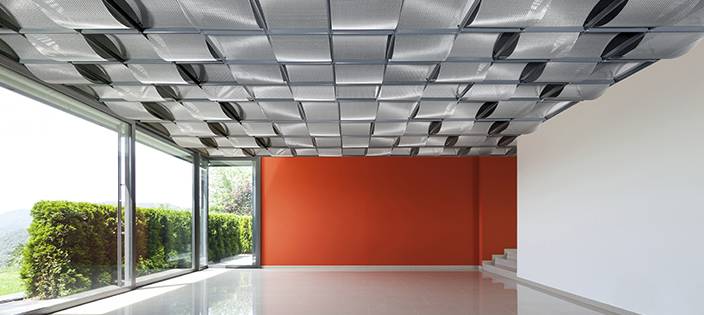How Architectural Wire Mesh Is Used for Ceiling Design
Architects continuously seek to create an atmosphere the visitors will remember for years. To do so, they must explore and integrate the various design material on the market.
Architectural wire mesh, for example, is an open product that delivers unique aesthetics without sacrificing durability. As a result, it is often used for various interior design applications, such as ceiling design.
So, how exactly does architectural wire mesh benefit ceiling applications?
For over 20 years, W.S. Tyler has made it our mission to take a deep dive into our customers' design process, learning it inside and out, to help them make the most out of architectural mesh systems.
That said, this article will cover:
- What architectural mesh is
- How architectural mesh is applied to ceiling design
- How architectural mesh benefits ceiling design
- How much architectural mesh costs
What Is Architectural Wire Mesh?
Architectural wire mesh is best defined as a series of individual metallic wires that undergo a specialized weaving process to form a high-tensile panel of typically 316 stainless steel wire mesh. While architectural mesh is predominantly constructed out of 80% recycled stainless steel material, it can be painted to resemble other alloys, such as brass, while maintaining stainless steel's durable qualities.
Regardless, all the parameters of the mesh panel, including the percentage of open area, mesh profile, wire diameter, and panel size, are calculated before the weaving process. This is to ensure the mesh panels can be integrated into your architectural design process seamlessly.
How Is Architectural Wire Mesh Applied To Ceiling Design?
The unique aesthetics of architectural mesh can create a one-of-a-kind atmosphere when applied to ceiling design. In fact, two- and three-dimensional profiles can be created to complement other interior design elements throughout the building.
With dozens of mesh profiles at your disposal, there are virtually no limits when turning your vision into a reality with architectural mesh. That said, there are three main styles of architectural mesh ceiling profiles: convex, ondula, and plano.

With the convex style, each mesh panel being used is installed in a manner in which it takes on a convex form.

The ondula style is similar to the convex style; however, the mesh panels are installed to alternate in convex and concave forms.

When applying the Plano style, the mesh panels are inserted into the ceiling system lying flat.
Why Use Architectural Wire Mesh for Ceiling Design?
Many benefits are associated with architectural wire mesh. That said, the most significant benefits include technical system protection, custom mounting systems, enhanced acoustics, fire resistance.
Technical System Protection
As stated above, architectural wire mesh panels are predominantly constructed out of stainless steel. This makes it one of the most durable and sturdy design materials with a flat viewing angle on the market.
It's because of these qualities that make it ideal for protecting covering technical systems. It can even be illuminated from different angles to create an opaque, semi-transparent, or fully transparent appearance, allowing it to provide maximum protection without interfering with the overall design of the room.
Custom Mounting Systems
One of the best qualities associated with architectural mesh is that, when applied to ceiling design, a custom mounting system can be created to ensure the panels fit your design. Regardless of what your mounting system requirements are, each system will come with the profile structure and the wire mesh elements.
This allows contractors to install the mesh system with ease.
Best of all, the mesh system can also be customized to accommodate sprinkle and ventilation systems to ensure your design complies with building codes.
Enhanced Acoustics
When wire mesh panels are constructed from round wires, sound is scattered in different directions when the sound waves with the mesh panel. Because the panels are pulled into tension and tightly secured to the mounting system, these sound waves won't cause distracting vibrations throughout the entire system.
This is particularly beneficial in large convention rooms, lecture halls, and performance arts halls.
Fire Resistance
As a stainless steel product, architectural wire mesh is considered non-flammable and complies with fire safety regulations.
How Much Does Architectural Wire Mesh Cost?
There are several factors that dictate the overall cost of an architectural wire mesh ceiling system. These factors include mesh type, fabrication, panel quantity, aperture, and weight.
That said, an architectural wire mesh system has an average cost of $25 per square foot. Naturally, when elements such as the wire diameter or opening sizes are altered, the system's overall cost is subject to change.
For a more in-depth breakdown of the overall cost of architectural wire mesh, review our article: How Much Does Architectural Mesh Cost?
Turn Your Vision Into a Reality With the Right Design Material
Architectural wire mesh is a unique design material that has the ability to deliver an exciting feel to various ceiling applications. Its one-of-a-kind aesthetics and functionality allow it to be used in spaces larger or small.
Having said that, it is important that you have a full understanding of the other design materials that can be applied. This will ensure you integrate the materials needed to truly turn your vision into a reality.
Having helped customers navigate through the various design materials available to them for over 20 years, W.S. Tyler is here to ensure your architectural design process is as seamless as possible.
To learn about how architectural mesh compares to another popular design material, read the article: Best Architecture Design: Perforated Plate Panel vs. Wire Mesh.
About Ronnie Brown
Ronnie is the Content Writer for W.S. Tyler and has four years of experience as a professional writer. He strives to expand his knowledge on all things particle analysis and woven wire mesh to leverage his exceptional writing and graphic design skills, creating a one-of-a-kind experience for customers.




